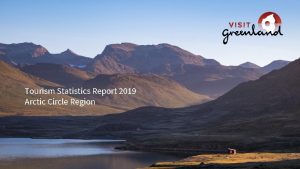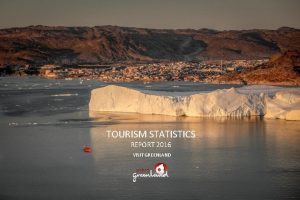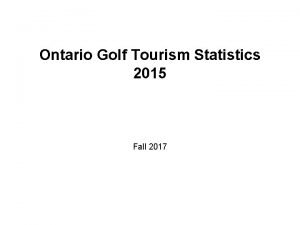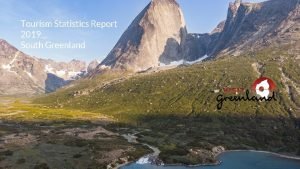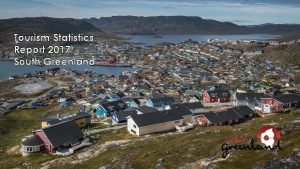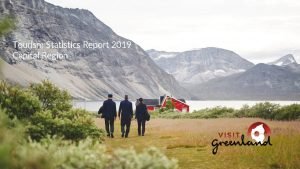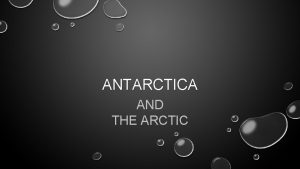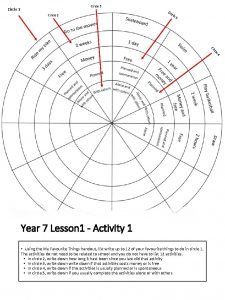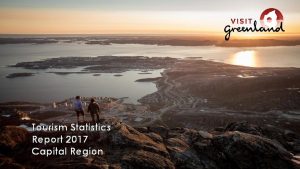Tourism Statistics Report 2019 Arctic Circle Region Introduction









- Slides: 9

Tourism Statistics Report 2019 Arctic Circle Region

Introduction 2019 became the year where the construction of the future Transatlantic airport in Ilulissat and Nuuk began. At the same time, it is still not 100 % clear to what extent after 2023 tourists will continue to be able to feed Arctic Circle Region via Kangerlussuaq Airport, as no plans for flights after 2023 have been announced yet. At the same time, the plans for a gravel road between Kangerlussuaq and Sisimiut have moved closer to realization with the completed tender of the first 21 km stage from Kangerlussuaq to Kangerluarsuk Tulleq with construction set to begin in July. The gravel road will certainly increase the tourism options in both Sisimiut and Kangerlussuaq, as well as offer more opportunities for businesses and the citizens in the area in general. On a national level 2019 saw both positive and negative developments and indicators. Unfortunately, we still do not have complete data regarding tourism in in Arctic Circle Region, as the registration of flight passengers in Kangerlussuaq also includes tourists in transit from other regions in Greenland. The number of tourists remains so low that even a variation of a few from a specific country segment will cause disproportionate percentage differences from one year to the next, so growth percentages can easily be overinterpreted. Furthermore, there is a natural variation in the demand from the international adventure market, which must also be kept in mind. It is therefore most appropriate to look at the development in tourism in Greenland on a national level and over a period of 5 or 10 years, as this is where we can read trends more clearly. Thus we can conclude that tourism in Greenland in the 4 -year perspective from 2015 through 2019 (we only have country of residence data on flight passengers since mid-2014) has been growing, both in terms of land-based tourism and cruise. In 2015 we registered approximately 51, 803 international flight passengers travelling out of Greenland incl. the DK segment. In 2019 we registered approximately 58, 149 international flight passengers, which is a growth of 12. 3 %. That is equivalent to an annual growth of approximately 2. 9 %. It is slightly under the average annual global tourism growth in the same period, but is must still be considered a healthy development. As this report deals specifically with the 2019 data on Arctic Circle Region one must keep in mind that is only the overnight stay statistics that provide solid indications on the land-based tourism development in the region due to the fact that the majority of international passengers out of Kangerlussuaq are travelling out of Greenland from other regions. On the other hand, we have relatively valid data when it comes to the number of cruise passengers.

Flight Passengers Travelling Out of Greenland via Kangerlussuaq Airport Though a small negative growth of -1. 4 % in the number of international passengers travelling out of Kangerlussuaq Airport, one must bear in mind that the majority of international passengers in fact feeds out of Greenland on their way from other regions through Kangerlussuaq Airport, so it does not necessarily say a lot about the number of visitors to the region of Arctic Circle Region itself. For the first time we are able to show data on all 29 segments that have been registered according to country of residence since 2016 (plus India since the 1 st of January 2019), and here one must note that of the ‘new’ segments Switzerland is placed as the 7 th largest tourist segment, if one does not count ‘Other Europe’ as an individual segment. Other new segments ranking relatively high are Australia as the 11 th largest tourist segment, Austria as the 12 th largest and Holland as the 14 th largest tourist segment. It is interesting to see ‘old’ segments such as Japan, Italy, Spain and Iceland are ranked lower than Austria in 2019.

Number of Overnight Stays in Arctic Circle Region Registrations are submitted covering 84. 3 % of the bed capacity in Arctic Circle Region. The remaining 15. 7 % of the bed capacity (measured by the number of beds) are CVRregistered accommodations that do not submit registrations. The reader must be made aware that an unknown share of the tourists sleeps under open sky, in private homes or in accommodations that do not submit registrations, so the following must be taken with appropriate reservations. Despite a healthy growth rate in the segments DK, US and DE, the total number of international (incl. DK) overnight stays have a negative growth of -1. 9 %. Germany as a segment has an ever more significant growth of a staggering 54. 7 %, which we do not seem to have additional data on to look further into. Great Britain also saw a relatively good growth of 26. 8 %, but with 841 overnight stays this growth number must be taken with reservations, as it is a statistically small sample, especially in relation to 663 overnight stays in 2018. Again, it should be noted that the new segment Switzerland is placed as the 7 th highest tourist segment. The advantage of the German speaking segments DE, CH and AT is that we can speak directly to them via over German version of visitgreenland. com/de.

Number of Individual Guests in Arctic Circle Region A positive growth of 2. 9 % can be observed in the number of individual international guests, while the previous page showed a negative growth of -1. 9 % in the number of international overnight stays. One of the explanations is found when calculating the average number of overnight stays for international guests, which in 2018 was 2. 2 vs. 2. 1 in 2019. The, on average, smaller number of overnight stays bought per international guest in 2019 results in a negative growth in the number of international overnight stays, but there is still a positive growth in the number of individual international guests. The graph on the left shows that Switzerland is currently ranked lower (number 9 tourist segment) than what was the case regarding to the number of overnight stays on the previous page. This is because the CH segment on average bought 2. 0 overnight stays, which is less than what was the case for most of the other tourist segments. The segment Spain surprises by representing a significant negative growth of -89. 6 % (from 182 guests in 2018 to 19 guests in 2019). The Indonesia segment shows a similar pattern. However, when the samples are so small a difference of only a few travel parties from one year to the next can cause large fluctuations in growth – negative as well as positive.

Seasonal Variation in Accommodations in. Arctic Circle Region The average occupancy rate in accommodations in Arctic Circle Region (the graph on the left) was 41. 5 % in 2019 vs. 43. 5 % in 2018. The spring season was better in 2018 than in 2019. In addition, 2019 also saw a surprising drop in June that is usually counted as a part of the summer high season. However, it must be noted that the occupancy rate graph on the left also includes Greenlandic citizens, which results in a more even occupancy rate in all months, except for December and January, which are significantly lower than the other months. We know that there are quite a few meetings, conferences, and the like in the home market, so that is a part of the explanation. The graph to the right only shows the number of international overnight stays over the 12 months of the year, and there the high season trend can be seen more clearly in July and August, as well as a smaller winter high season in February through May. The winter high season in 2019 was better than in 2018, whereas the summer high season in 2018 was better than in 2019 saw more international overnight stays in October than in September, which is unusual. 6

Cruise Tourism Nationally and in. Arctic Circle Region 2017 and 2018 alike saw a significant growth in the total number of unique cruise passengers in Greenland (the graph on the left), the equivalent of a 57. 5 % growth from 2016 to 2017 and a 19. 8 % growth from 2017 to 2018. From 2018 to 2019 the increase was ‘only’ 2. 0 %. When in the graph on the right, we look solely at the number of passengers for each city in Arctic Circle Region in 2018 and 2019 we note a decline in Sisimiut and Kangerlussuaq, but an increase in Maniitsoq. Overall Arctic Circle Region has seen a decrease of -8. 4 %. The number represents the number of passengers on ships that called on the 3 cities, but most likely not all passengers have come ashore on every port call, but rather a certain share of them. From a 2015 survey we know that 98 % of all the passengers came ashore at least once during their cruise, which typically has between 2 to 5 port calls in Greenland.

Cruise Tourism – Number of Port Calls According to Capacity 2018 -2019 The graph below shows the number of port calls in Arctic Circle Region in 2018 and 2019, according to the 4 so-called ‘pax classes’ – i. e. according to the passenger capacity of the ships. The 2 largest pax classes experienced status quo, whereas there was a decline in the number of port calls for the 2 smallest pax classes, which helps explain the negative growth of -8. 4% in the total number of passengers aboard in port calls in Arctic Circle Region in 2019. In 2018 there was a total of 104 port calls, whereas the total number in 2019 was 91 port calls. The fact that Arctic Circle Region has seen a decline in the number of passengers and port calls, while there has been a growth at a national level, cannot be immediately explained in the data at hand. This can be due to natural fluctuations in the cruise market due to different sailing plans from year to year, and changes to what ships sail which waters from one year to the next.

Final Thoughts As so many times before there are both positive and negative indications in the tourism data. Regarding accommodations there was a growth of 10. 4 % in the number of unique international guests (also called the ‘head count’ – incl. the DK segment), while there was a decline on -1. 9 % in the number of international overnight stays (incl. the DK segment). As for passengers travelling out of Greenland via Kangerlussuaq Airport we, unfortunately, do not have data on how many of the passengers were merely passing through Kangerlussuaq on their way home from other regions they visited in Greenland, and how many were in fact tourists in Region Arctic Circle Region. In the cruise field we must note a decline of -8. 4 % in the number of passengers aboard the ships while they called on Arctic Circle Region, which of course is not positive news, but can be ascribed to natural fluctuations in the sailing plans of the cruise lines from year to year as well as the shifting trends in the cruise market. The construction of the gravel road between Kangerlussuaq and Sisimiut is followed with excitement. Investments in traffic infrastructure most often increase the development opportunities in a region, especially when the existing passenger transport is almost exclusively carried out by plane. Aasivissuit-Nipisat’s recently awarded status as UNESCO World Heritage should at the same time increase the opportunities to both develop new products and make it easier to market. We wish you all the best possible 2020 season despite the Covid-19 crisis! Best regards Visit Greenland Compiled by Mads Lumholt, Visit Greenland, May 2020
